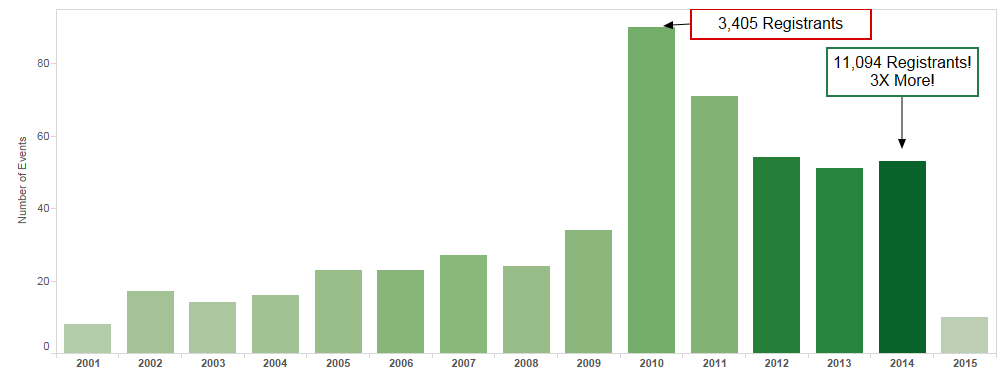Often association leaders ask me, “Where is the best place for us to begin our data analytics initiative?” I like this question and am reminded of Steven Covey’s expression that before we undertake a new initiative, we should “begin with the end in mind”. When it comes to data analytics for associations, this means starting with your strategic plan.
One association’s strategic plan, for example, specified that they would grow meeting attendance by 10% in 3 years. This was their largest source of revenue.
In the past the association made decisions by looking at historical trends and was unable to confidently estimate expected attendance, revenue, venue amenities needed, onsite staffing levels and more. In fact, the more events they held, the greater the risk of an incorrect estimate.
Yet because of the strategic initiative to increase attendance, the first thing they tried was to increase the number of events and market them by email campaigns and direct mail.
The visualization below is a simple bar chart showing the number events by year. The higher the bar, the more events. The color shading of the bars indicate the number of registrants. The darker the green, the more registrants. We can quickly see 2010 had the most events, but not the most registrants. In other words, although the association increased the number of events, this did not increase the number of attendees. In fact, holding more events actually caused a decrease in meeting profitability as a whole, since there were more expenses associated with fewer registrants.
By reducing the number of events by combining smaller, similar events to a larger meetings, the organization was able to dramatically exceed the target set by the board. In other words, by holding fewer events, they had more participants.
What is the Cost of Not using Data?
When making business decisions it’s important to weigh the costs of:
- Bad decisions
- Decision delay
- Lost opportunities
- Damage to image/reputation
Often these costs are much greater than the costs associated with analyzing data. Taking a “decision tree” approach can be a logical way to evaluate where to start:
- Are there areas in your strategic plan where data can answer questions, provide insight and direction?
- Which areas do our customers care about? Will it make a difference to them – add more
value, improve their experience – advance our mission? - Do we have the data – or can we get it?
- Will we be able to take action on the results of the analysis?




